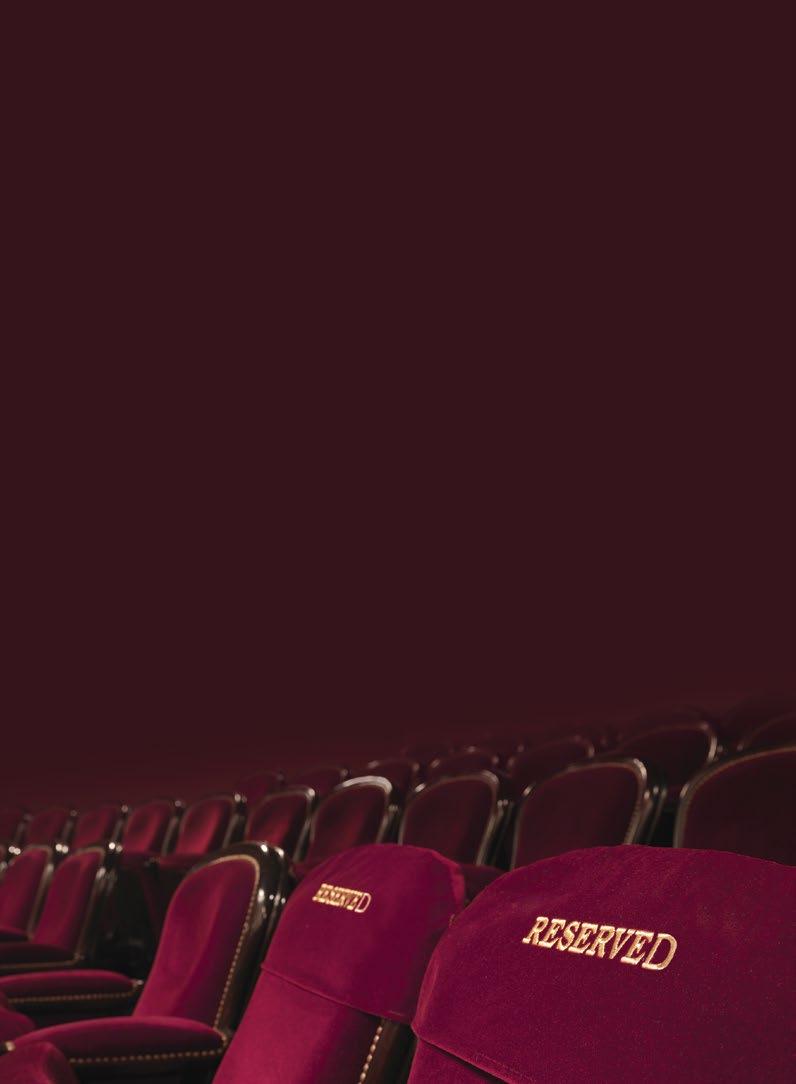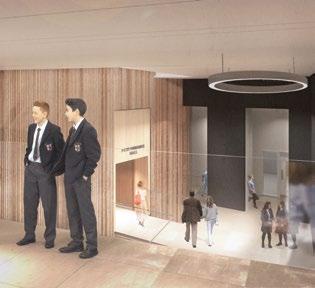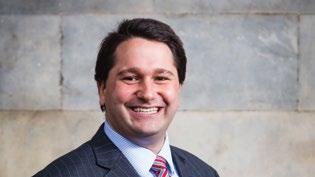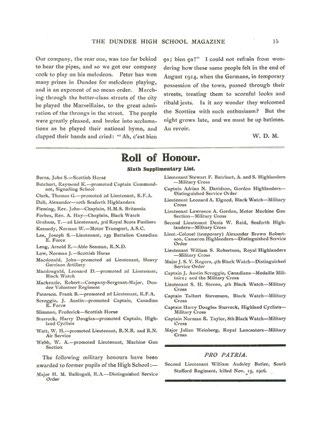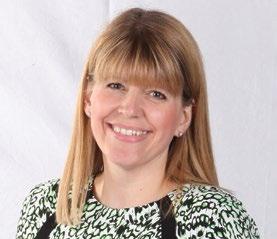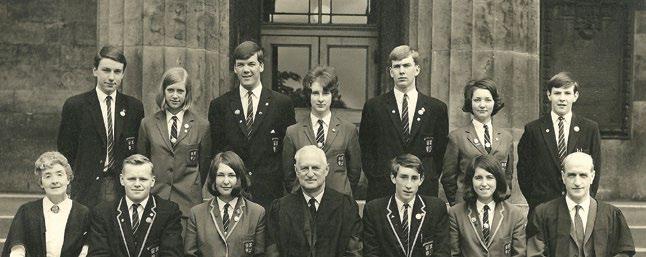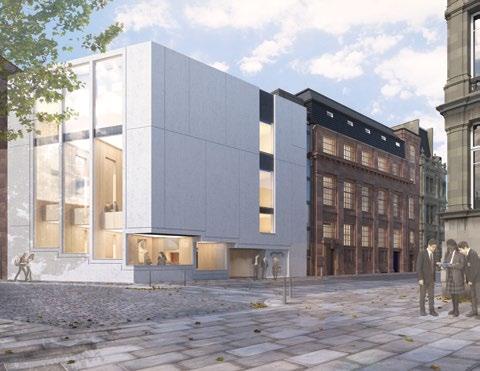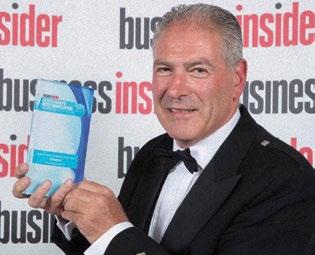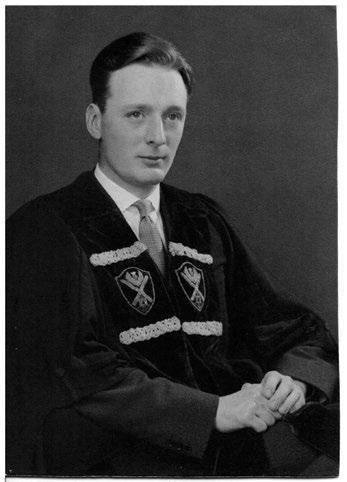
14 minute read
Tristan Cameron-Harper
Former Pupil Tristan Cameron-Harper has most certainly hit the heights since leaving the High School of Dundee in 2003. Most impressively, he has played Professional Hockey, before retiring from the sport in 2016. Having now found a love for the outdoors, especially in the beautiful Scottish countryside, Tristan’s career is going from strength to strength.
First Chapter
Throughout his time at school, Tristan’s two major passions were Ice Hockey and Rugby. Upon being offered a scholarship for Banff Ice Hockey Academy, in Alberta, Canada it was clear which of his passions he was due to follow. Speaking of this opportunity, Tristan mentions how ‘(I) had the choice to stay, focus on my studies, and pursue Rugby, or take up the scholarship I had been offered in Canada. In the end, I had the urge to take a chance with playing Ice Hockey’. Having moved to Canada, he lived there for two years, playing Ice Hockey for the Banff Icemen. Later, being afforded the opportunity for his first professional deal aged just 17, with Nijmegen Emperors, in the Netherlands. Throughout his first season playing with the team, they won the Dutch Championship, which is described by Tristan as an ‘unbelievable experience, one that I will never forget’. After his incredible first year as a professional, he was scouted by Northern Michigan, who play division 1 hockey in the United States. Michigan suggested that Tristan sit his SATs as well, however, described as a ‘more physical, and hands on person’, Tristan and the managers reached a conclusion that agreed he would take the semi-pro route instead, before possibly progressing to the main league. He played one season with the St. Louis Bandits, and also two seasons with the Alpena IceDiggers. Later he was scouted by the Edmonton Oilers in the NHL, who hoped to draft him into their squad for a season. Unfortunately, this fell through due to the NHL going into lockout that season, and as a result all games were sadly cancelled. Not letting this halt his passions, Tristan then headed back to the UK, playing professionally for the Nottingham Panthers, Dundee Stars, Hull Stingrays, and finally, the Braehead Clan, where he was an EIHL Gardiner Conference Champion in 2014/15, and 2015/16. One thing Tristan never truly realised about Ice Hockey, until he moved out to Canada at the age of 15, was that a major part of it involved fighting with opposition players. This tactic was utilised to rile up other team mates, and also to provide ripples of excitement to the crowds. Eventually, he hung up his skates at the end of the 2016 season to pursue a new form of adventure.


During his first year playing for the Braehead Clan, he was scouted in the streets of Glasgow by modelling agency, Model Team, who thereafter signed him up. He began modelling, as well as appearing at a variety of events, where he met his current blog partner, Jawn McClenaghan. A shared passion for the outdoors, as well as photography, led to them starting a business together. You can see here their adventures here: www.north-blog.com. In 2016, Tristan had begun to fall out of love with Ice Hockey, and had developed a keen interest for the outdoors. This inevitably led to his decision to retire from Ice Hockey. Upon being invited to a BBC production, The Social in Glasgow, Tristan, along with friend Finlay, brainstormed an innovative business idea. Pitching this to the BBC, and subsequently getting the approval they desired, provided the opportunity for Kilted Yoga to be born. Five hours’ worth of filming at The Hermitage woods, near Aberfeldy, led to the creation of an internet sensation, with over 60 million views on YouTube to date.
From this success, a huge window of opportunity arose for Tristan, with more offers of modelling jobs from the likes of notable brands including Trespass, Giorgio Armani SPA, Christian Dior SE, and Ford Motor Company to name but a few. Furthermore, he has also featured regularly in GQ.
Towards the end of 2016, Tristan was chosen to represent Scotland at the ‘Mr. Universe’ contest, competing against forty-eight other nations. Having assumed it would simply be a male version of a beauty pageant, he was taken aback when he discovered exactly what the five challenges he had to complete entailed. As well as a Sports Challenge, an Extreme Challenge, and a Multimedia Challenge, there was also a Talent & Creativity Challenge, and a Fashion & Style Challenge. After finishing in sixth place overall, Tristan described the experience as ‘…a great achievement, but… just being there was what really mattered’. In between these achievements was the aspiring mountaineer’s excursion to Mount Everest’s Base Camp, a trip that Tristan utilised as a test to see if this was what he wanted to pursue. Reflecting on the descent into Lukla airport from Kathmandu, which is notably ranked in the top 10 most dangerous airports in the world, Tristan describes ‘a feeling of relief when we landed safely’. Lukla Airport has an extremely short runway at just 1,729feet long, and with no control tower, radar, or navigation, pilots

are forced to rely on their own vision from their cockpit in order to land safely. A terrifying 10,000ft drop awaits at the end of the runway, should a pilot misjudge their landing. Upon discussing the expedition itself, Tristan marvelled at how ‘absolutely beautiful’ it was. Miles from cars, conveniences, and daily luxuries, he was surrounded by stunning scenery, and mother nature at its absolute finest. The trek stretches over a period of 14 days, allowing explorers to visit places such as Namche Bazaar, the biggest Sherpa village in Nepal, as well as trekking across suspension bridges spanning chasms of thin air, and through multiple hidden Buddhist monasteries. The excursion truly is the trip of a lifetime, with Tristan mentioning his intentions to return to Mount Everest in the future, but this time with a view to successfully reaching the summit. In more recent months, Tristan has undertaken further, and just as exciting, adventures to Peru, Southern California, and Mont Blanc. Returning from summiting Mont Blanc at the beginning of October, Tristan recalls the exhilarating rush of finally reaching the top, describing the breath-taking view above the clouds at sunrise as an ‘amazing feeling’. What’s Next
On the horizon for Tristan are some planned expeditions to Nepal. This will hopefully allow him to conquer Mount Everest in its entirety. Further plans include a visit to Mongolia, and multiple modelling shoots scheduled to take place in Norway – a stunning backdrop. A larger scale project in the pipeline, is Tristan’s participation in an excursion to the Northern Pole of Inaccessibility, which entails an 80-day trek of over 800 miles. With a team of twenty-eight people, the teams will be split into four, with seven people per team. Each team will complete 20-days of the overall trek, before the next group take over. Facing fiercely low temperatures, disintegrating ice flows beneath their feet, and the possibility of encountering ravenous polar bears, means this adventure will be no easy feat. Having being labelled as the biggest, boldest, bravest, and most important expedition of our time, this will provide expeditioners the chance to visit an extraordinary place, to collect vital information for the future of our planet. The main focal point is to collect crucial data on climate change, from an area that up until now, Scientists have never been able to reach.


Editor, Edward Findlay took the opportunity to conclude his interview with Tristan reflecting on his time at the High School of Dundee.
What were your main interests at School?
Rugby and Art, because I was able to express myself. I also enjoyed Drama and Music, being able to express myself made me more confident. What were your ambitions then and have they been fulfilled now? I always had a goal of being a Professional Hockey Player, and I achieved that goal. I am lucky enough that I have been able to travel the world. It was always a ‘what if’ with Rugby, and it was hard for me to leave that sport as I missed it so much. The Canadians were never any good at Rugby! The High School of Dundee is one of the best schools in Scotland for Rugby, and I am proud to say that’s where I learned to play as a kid. Who was your favourite teacher?
Oh that’s a hard one! Miss Mooney, a Primary School Teacher. I liked Miss Thurston, the Art Teacher, a lot. Also, Miss Keogh, an English Teacher. Even though I was useless, she always used to have a laugh, and a chuckle with me, supporting me in everything I did. Also I liked Mr. Hutcheson, who was a Gym Teacher. What was your favourite extra-curricular activity? Games was my favourite, there were ten extra-curricular classes, and you picked one from a hat, so I got games, which was playing PlayStation and Xbox, it was brilliant! Also I was really into drama. Do you still keep in touch with a lot of School friends? I still keep in touch with a lot of friends from School, a lot have stayed in Scotland, and you get a few who have gone and travelled the world, seeing loads of cool stuff. I still bump into a lot of people, Dundee is a hub for meeting people that’s for sure! Did you go on any School trips? If so, what was your favourite?
We only went on one School trip, and that was to Pitlochry, so not as exciting as some of the school trips the kids get to go on these days, but it was a fun trip. Although, all the kids on the trip got ill, and the parents had to come and collect us, up until then it was a good trip. Which House were you part of when you were at School?
I was part of Wallace, as was the rest of my family when they attended the School. What’s your biggest achievement to date? I don’t think I have achieved a lot, but I am trying to encourage others, and inspire people that I come in touch with, to find what they are excited about.
images by Jawn McClenaghan – www.jawnphoto.com
Have you started planning your family ' s educational future?

Jonathan McDowall
Financial Planning Consultant Henderson Loggie Financial Services
It's important to start as early as possible when planning your family's educational future. In this article, Jonathan McDowall from Henderson Loggie Financial Services takes a look at some financial planning options for funding education, along with some trust funding options from Alison Beattie of Henderson Loggie Chartered Accountants.
As a parent, you need to be confident that you can afford the fees throughout the course of your child’s education. With adequate planning, you can ensure you are funding fees in the most effective manner, as well as avoiding problems at a later date.
Forecasting future cost and affordability
The starting point is to assess the current and future cost of school fees. Preparing a detailed cashflow analysis will estimate your income, assets and expenses to ensure you can afford the fees in the future.
A cashflow analysis may identify shortfalls in meeting fees, allowing a bespoke plan to be created.
The key benefit of a cashflow analysis is to determine how best to allocate your capital and income in the most tax efficient manner. After all, if you pay less tax on your savings and investments then you will have more disposable capital and income to meet the cost of school fees.
Planning Ahead for Future School Fees
Early planning is key to ease the financial burden of school fees. Consideration should be given as to how your income and capital is best used to provide for future school fees.
If capital and/or surplus income is available, investing early can prevent or reduce the need to rely on your annual income. There are various savings and investments that can be utilised to make the most of available income/capital.
It’s important to utilise available tax efficient allowances. This could start with allocating capital between parents to make use of both personal and savings allowances for income tax. ISA allowances also provide an effective tax-free shelter for capital.
To maximise savings and capital, utilising pension contributions and other government approved investments that qualify for tax relief, could not only provide an effective investment, but potentially allow greater savings to be made from the tax relief provided. Creating a plan to invest in assets that do not produce taxable income (or very little) can also help to lower your total tax bill. For example, taking advantage of the favourable tax position of investments which are subject to Capital Gains Tax rather than Income Tax.
Meeting the immediate cost of school fees
There may be occasions where having embarked on educating your child independently, you may experience difficulties in fully funding school fees from your annual income. Consideration could be given to releasing equity in your property to provide additional capital to meet shortfalls. This may represent an attractive option with the current low interest rates available on mortgage borrowing. However, your plan would need to take account of potential interest rate rises.
If fees are affordable out of annual income, there is still a need to ensure you are utilising tax efficient allowances and reliefs, to reduce taxation and potentially help free up additional income.
School fees protection
There are a number of events that can result in financial difficulty and affect the affordability of school fees. Therefore, it is important to consider protecting your children against such unforeseen events as death, long-term incapacity and serious illness, with a tailored insurance policy. These policies could help to ensure financial security and maintain the continuity of your child’s education.
Funding from Grandparents
It is common for grandparents to help with funding their grandchildren’s education. In this scenario, there are further options that could be considered to meet the cost of school fees. For example, investing capital in trust that can be assessed against the child’s tax position when school fees are to be paid, potentially allows capital to grow and be accessed without being subject to tax. This may also provide additional benefits to grandparents who have a need to mitigate Inheritance Tax.
The Benefit of Taking Advice
Planning ahead for the cost of your children’s education will be important to ensure the cost is quantified and affordable. Taking advice to ensure that you have taken account of all options available to best meet your individual circumstances could not only help to meet the cost more effectively but may also help to reduce the overall financial burden.
Trust planning options
Alison Beattie
Senior Tax Manager Henderson Loggie Chartered Accountants
If you own shares in a private company and receive dividends from your shares, you should consider arrangements that could provide significant savings.
Our planning involves using a Trust, through which the dividend payments are directed. The shares are transferred into a Trust and dividends declared on those shares. By appointing an interest in the Trust’s income to your child or children, the dividends are taxed at their personal rates of tax rather than at your higher or additional rates of tax.
As an example, if your child requires net income of £12,000 to fund their accommodation and living costs for university, you may have considered taking extra dividends to enable you to fund the University costs. This involves additional costs to the company and additional tax costs to you as an individual particularly if you are an additional rate taxpayer.
The figure shown bottom right is the potential saving per child per year when using our planning solution rather than funding the cost from your own net income.
NEED MORE ADVICE OR A SECOND OPINION?
jonathan.mcdowall@hlfs.co.uk
01382 207060
alison.beattie@hlca.co.uk
01224 322100


£14,772
Potential Saving per child per year
The savings have been calculated based on the additional dividend the company would have to declare and the tax on the dividend at additional rates to provide a net receipt for the individual of £12,000. For individuals who are not additional rate taxpayers but have other income there will still be savings through using the Trust approach. The example is for illustration purposes only and should not be relied upon without advice specific to your circumstances, particularly in relation to taxation.

